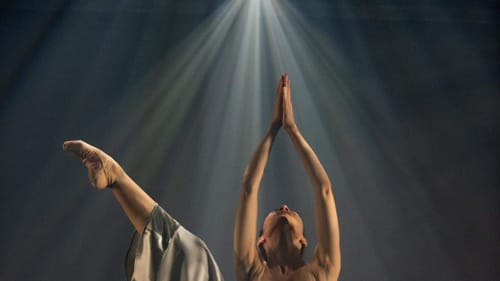Stay in the Loop
BSR publishes on a weekly schedule, with an email newsletter every Wednesday and Thursday morning. There’s no paywall, and subscribing is always free.
A new start at the Garage
The Philadelphia Ballet presents The Spark

With just 70 seats, the Performance Garage is an unusual venue to open the Philadelphia Ballet season (its first since a major rebrand). It’s not the Perelman, where it had planned to be before the pandemic, but the space has had some recent renovations, including new seating and a steel mesh ramp, that make the audience area more comfortable, and less dangerous to navigate, than the balcony at the Merriam where audiences used to see the company’s contemporary ballets. And the dancing, in a program titled The Spark, was everything we expect from this company.
The Other Half and Connection
The evening opens with Matthew Neenan’s The Other Half, set to a noise score composed by frequent collaborator Rosie Langabeer, who referenced 60s cool with a recurring mambo rhythm. Even the costumes, Reid Bartelme and Harriet Jung’s concoctions in black and red and fishnet in particular, fit the 60s vibe, and the group pieces seem like a whimsical cross between a perpetual-motion machine and the Monkey (yes, that was a real dance). But the duets make the piece for me. Sterling Baca’s partnering is exceptional and in his many low lifts, Yuka Iseda seems to float like a feather, all done with a sly glee that pulls you right in. Zecheng Liang and Jacqueline Callahan bring the sexy, but the lushly romantic duet between Jack Thomas and Jack Sprance is the beating heart of the piece.
The company performed Juliano Nunes’s Connection in November 2019 as part of its last contemporary ballet triple-bill before the pandemic, so I was surprised to see it again so soon. But it seems a fitting piece to celebrate our own returning connections to the living arts. To the intense music of Ezio Bosso, Liang rises from the center of a circle of dancers. He seems to be breaking free, but over a series of set pieces, the solo becomes a duet with Iseda. The bravura moment of the piece belongs to Nayara Lopes, when she flings herself at Thomas, her arms spread wide—she can fly, because she trusts he will be there to catch her. Finally, the circle draws Liang back into the community, but this time he is not alone. (The company will be commuting to New York City this week to make new connections at the New York City Center Fall for Dance Festival.)
Corella steals the show
The most surprising piece of the night was Angel Corella’s Landscaping the Mist, set to the music of Phillip Glass (with Martha Koeneman on electric piano). As Mist begins, the dancers cross the stage one at a time on the diagonal path, the women in soft gray dresses that flow almost to their ankles, the men in soft slacks and tops a darker gray. Suddenly, the stage fills with dancers—more than 20 of them—so close that it feels like we ourselves are caught in the soft gray mist of the dancing.

Corella has talked in the past about his love of the corps, and Mist is his love letter to those too-often underappreciated dancers. He makes them work for it, though. Minimalist music starts with a rhythmic pulse and layers sound in ever more complex and urgent iterations around that basic pulse. It can create an overwhelming sense of heart-pounding speed that is hard to measure or keep up with, even when the steps themselves are not complicated. So the dancing could have felt chaotic in that tight space.
But Corella constrains the almost frenetic movement of the individual dancers within disciplined, geometric patterns. Instead of dashing across the stage, they stand in one place, their feet beating the rhythm on the floor, or break into squares and spirals that resolve into columns.
The heart of the mist
Corella slows things down a bit for a sequence of duets, solos, and trios before he picks up the pace again. One of the great successes of the piece is its marriage of classic steps familiar to the corps with the speed and sensibility of Glass’s music. Lines of dancers swiftly cross between each other, and male dancers jeté across the stage, leaping between the women on the floor. In a solo with the corps behind her, Dayesi Torriente could have been queen of the mists.
The costumes were not credited for this ballet, but they are beautifully effective. Minimalism is often performed in jewel-colored unitards or other more contemporary costuming that highlights its modernism. In soft grays and flowing dresses, however, the dancers seemed to become the mist.
Corella has taken the classic ballet blanc so beloved of second acts, modernized and exploded it, and opened it up to include the men of the corps. In doing so, he has found a romantic heart in Glass’s music and offered it to us as a gift.
What, When, Where
The Spark. $82.50. Choreography by Matthew Neenan, Juliano Nunes, and Angel Corella. The Philadelphia Ballet. Through October 30, 2021 at the Performance Garage, 1515 Brandywine Street, Philadelphia. (215) 893-1999 or philadelphiaballet.org.
Audiences must wear a mask and show proof of Covid-19 vaccination with photo ID.
Accessibility
To make reservations for the limited accessible seating, call (215) 893-1999 or TTY (215) 875 -7633.
Sign up for our newsletter
All of the week's new articles, all in one place. Sign up for the free weekly BSR newsletters, and don't miss a conversation.

 Camille Bacon-Smith
Camille Bacon-Smith